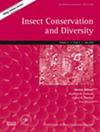Reviving of Coenonympha oedippus: A comprehensive approach to the reintroduction of an endangered European butterfly
IF 3.2
2区 农林科学
Q1 ENTOMOLOGY
引用次数: 0
Abstract
鹅膏蝶(Coenonympha oedippus)的复苏:重新引入欧洲濒危蝴蝶的综合方法
在这项研究中,我们的重点是受欧盟栖息地指令附件 II 和 IV 保护的濒危蝴蝶物种 Coenonympha oedippus。该物种主要栖息于欧洲各地的半开阔湿草地,也栖息于被遗弃的亚地中海干草地。其生境利用的生态独特性体现在幼虫寄主植物、翅膀形态和基因组成的差异上,从而形成了两种生态型:湿型和干型。值得注意的是,到 2018 年,斯洛文尼亚仅有一个湿生态型种群存活,因此有必要将重新引入作为避免其在全国灭绝的关键策略。基于我们的保护目标,我们实施了一个为期 5 年的项目(2018-2022 年),以制定源个体和基质采集、半自然条件下的异地繁殖、彻底释放和释放后监测协议。我们的工作包括从 18 只雌鸟中进行繁殖,在繁殖舍中产出 754 枚卵。从中,我们成功饲养并释放了 460 只个体,包括 419 只蛹和 41 只蝴蝶。该项目最终取得了可喜的成果:重新引入的种群增长率为 87%,而来源种群在上次增殖后的增长率为 79%。项目的成功归功于对物种生态需求的全面了解和长期管理计划的制定。适应性管理是我们方法的关键,它允许在实施过程中灵活调整和完善协议。对所有项目活动进行细致的记录和评估非常重要,最终形成了标准化的年度报告。此外,科学家、遗址管理者、政府机构和国家媒体之间的紧密合作也为该项目提供了支持。
本文章由计算机程序翻译,如有差异,请以英文原文为准。
求助全文
约1分钟内获得全文
求助全文
来源期刊
CiteScore
7.70
自引率
8.60%
发文量
58
审稿时长
>12 weeks
期刊介绍:
To publish papers of the highest scientific quality within the general area of insect (and other arthropods) conservation and diversity covering topics ranging from ecological theory to practical management.
Papers are invited on the following topics: Conservation genetics; Extinction debt; Long-term conservation planning and implementation; Global implications of local or national conservation actions; Management responses of species and communities; Captive breeding programs; Comparisons of restored and natural habitats; Biogeography; Global biodiversity; Metapopulation dynamics; Climate change: impacts on distributions and range; Invasive species: impacts and control; Effects of pollution; Genetic threats to diversity by introgression; Effects of fragmentation on diversity and distribution; Impact of agricultural and forestry practices on biodiversity; Enhancing urban environments for diversity and protection; Biodiversity action plans: can we scale up from insects?; Effectiveness and choice of indicator species; Soil biodiversity and interactions with above-ground biodiversity; Ecological interactions at local levels; Ecological and evolutionary factors influencing diversity and local, regional and global scales; Sustainable livelihoods and training on the ground; Integrating science and policy.

 求助内容:
求助内容: 应助结果提醒方式:
应助结果提醒方式:


